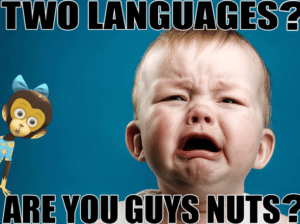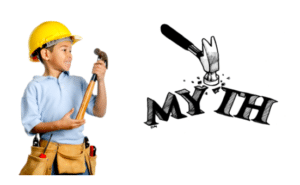This Scribble was scribbled by Krysta Leong Poi (Speech and Language Therapist at TCP)
I’m always amazed when I walk around the city of London and hear all the different languages being spoken around me. The last census revealed that there are over 100 languages spoken in 30 of London’s 33 boroughs each of London boroughs – that’s an astonishing amount of diversity! As you can imagine, working as a speech and language therapist (SLT) here, I meet many families that are bilingual (or even multilingual). Bilingual language development is fascinating – it’s a complex and dynamic process and varies from child to child, depending on their environment, amount and timing of language exposure and many other factors.
Let’s first start off by defining bilingualism. Bilingualism occurs when a person can communicate in more than one language. The bilingual child can acquire language in two ways, either through simultaneous acquisition, where a child is raised speaking two or more languages from birth or before the age of 3 years and sequential acquisition, when a second language is introduced generally after the age of 3.
If you are the parent of a bilingual child, especially one that has speech or language difficulties, I’m certain that at some point you’d have wondered whether your child’s language development may be affected by learning two or more languages. Over time, there seems to have been many myths that have creeped up in bilingual literature – let’s try to debunk those myths together!
MYTH 1: Bilingual children do not develop language like monolingual children.
Every developing child is unique and the amount and quality of the languages that the child is exposed to plays a role in their language development. Like any typically developing child, bilingual children will usually say their first word by 12 months and by about 24 months, will start combining words together to form two-word utterances (e.g. no juice, daddy go). The development of grammatical rules follows a similar pattern to monolingual children.
In some cases, bilingual children may go through a ‘silent phase’ when he/she is first exposed to a second language. This is often attributed to the child building their understanding of the language. Later on, the bilingual child may start using short sentences such as ‘what’s that?’ or ‘I don’t know’ These phrases tend to be learnt phrases and are usually ones that the child has previously heard and memorised and repeats in different situations. Eventually, the bilingual child will begin to formulate their own sentences, using vocabulary that is newly-learnt. Over time, as he/she becomes more fluent, they will begin producing novel sentences and no longer have to rely on learnt structures.
MYTH 2: Bilingualism causes language delay.
Bilingual children may sometimes say their first words slightly later than monolingual children but their first word is still produced within the expected age range (between 8-15 months). In looking at the vocabulary size of each language of the bilingual child, they may be slightly smaller than average, however, their collective vocabulary (vocabulary size from both languages) are around the same size as a monolingual child’s vocabulary. As noted above, the development of grammar follows similar patterns to bilingual children. As a general guideline, if a child is showing signs of delayed or disordered language, this will be evident in both languages spoken by the child.
MYTH 3: If your child is mixing both languages, that means they are confused and are not acquiring language typically.
When a bilingual child is combining elements of both languages, this does not mean that they are confused or that they are having difficulties with language. This is a very typical process called ‘code switching’. This often occurs when a child is matching their language to that of their communication partner (e.g. a child may speak more Urdu words when communicating with an Urdu speaker) or when the child has knowledge of a word in one language but not in the other language.
Additionally, typically developing monolingual children make speech and language errors all the time. This is all part of the language learning process and bilingual children will make errors as well.
MYTH 4: If your child has language difficulties, speaking more than one language will negatively affect their language development.
Studies have shown that bilingual children with language difficulties are not negatively affected by speaking more than one language. Research with children who had language difficulties secondary to Down Syndrome, Autism Spectrum Disorder (ASD) and language impairment were not observed to have any extra difficulties compared to monolingual speakers and scored similarly on standardised tests of language.
MYTH 5: If your child has a language delay or language difficulties, you should speak to them only in one language.
If your child is attending a school where your home language is not spoken or is receiving speech and language therapy by a SLT who does not speak your child’s home language, many parents opt to communicate with their child in the language of instruction as opposed to their home language. However, talking to your child in a language with which you are not fully comfortable can make interactions between you and your child unnatural. Also, if your child is the only one at home that is not conversing in your home language, he/she may feel isolated during interactions between you and your other family members, creating a negative socio-emotional impact.
If one parent speaks one language and the other parent speaks another language (e.g. dad speaks French, mum speaks Arabic), you should both speak to your child in the language that is most comfortable and natural to both of you.
MYTH 6: There is a window of time that you should introduce a second language to your child or they will not develop the second language well.
Earlier research has highlighted a ‘critical period hypothesis’ which implies that in early childhood because of the way a child’s brain is developing, a second language is easiest to learn. While research has shown that if a child learns a second language in earlier years he/she will have more native-like pronunciation and long-term grammatical skills, more recent research has shown that older children can acquire language just as well as younger children.
MYTH 7: If your child is stronger in one language than in another, that means that something is wrong and that he/she is not truly bilingual.
Bilingual individuals are not always equally proficient in both languages, so you should not be concerned if your child is stronger in one language than another. Even grown adults have a dominant language where there is a higher level of proficiency. The dominant language can always change because of life circumstances, employment, school etc.
There are many benefits to being bilingual, including greater access to people and resources and higher levels of creativity and problem solving. Being bilingual can even delay the onset of diseases like Alzheimer’s and dementia. In supporting your child who is bilingual:
- Speak in the language with which you are most comfortable.
- Always remember to provide a language rich environment where your child has many opportunities to hear, speak, play and interact in their home language.
- It’s fine if your home language is not the language that they are hearing in school or in the community.
- Don’t worry if your child is mixing two languages or if your child is more proficient in one language than the other. This is all part of the process.
- Finally, remember, bilingualism does not have any negative impact on language learning.
- If you have concerns that your child has a language delay or difficulties with language, it is always best to consult a SLT who can provide you with the best strategies, specific to your child, to help them learn more than one language.
Now that we’ve dispelled the bilingualism myths, enjoy the process of language learning with your little one!
References:
- http://www.hanen.org/Helpful-Info/Articles/Bilingualism-in-Young-Children–Separating-Fact-fr.aspx
- http://www.asha.org/practice/multicultural/issues/bll.htm
- http://www.asha.org/public/speech/development/BilingualChildren/
- https://www.youtube.com/watch?v=LVYhpCprtzQ&feature=youtu.be
- http://ed.ted.com/lessons/how-speaking-multiple-languages-benefits-the-brain-mia-nacamulli
- http://www.standard.co.uk/news/london/census-data-shows-100-different-languages-spoken-in-almost-every-london-borough-8472483.html




Leave A Comment